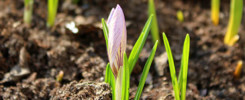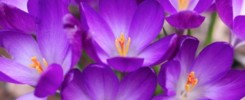 Submitted By: Egan Davis, Principal Instructor (UBC Botanical Garden)
Submitted By: Egan Davis, Principal Instructor (UBC Botanical Garden)
 Weeding often seems like a never ending task, knowing that once it’s done, it is only a matter of time before the weeds grow back again. Not only is this annoying, but it is detrimental. Every time weeds are removed, precious soil is also taken away as it clings to their roots. This is a terrible cycle in the garden.
Weeding often seems like a never ending task, knowing that once it’s done, it is only a matter of time before the weeds grow back again. Not only is this annoying, but it is detrimental. Every time weeds are removed, precious soil is also taken away as it clings to their roots. This is a terrible cycle in the garden.
In order to correct this behavior it is important to understand the ecological role weeds have. In nature, when there is a disturbance such as a fire, a landslide, a flood, or even animals digging, soil is left bare and exposed. If left bare, soil is damaged by the drying sun, eroded from rain and blown away in the wind. The ecological response is a prolific germination of fast growing annual plants that protect and stabilize the soil, and store nutrients in their tissues. These plants also flower quickly and continuously so that the site can continue to support pollinators and biological activity until a more stable plant community can re-establish itself. This is called the weed response and it requires soil disturbance and bare soil.
Many common gardening activities such as hoeing, cultivating and raking create the disturbance which actually triggers the weed response. The seed bank of weeds in the garden is for all practical purposes, limitless, and every time the soil is disturbed, a new crop of weeds will germinate. The very act of weeding promotes the growth of more weeds.
In nature, soil nearly always has a protective cover. This covering exists as plants, leaf and twig litter, or gravel and rocks. Even in wild areas that seem to show only bare soil, such as in the desert, there is a protective crust of undisturbed soil that is held together by algae, fungal mycelium, lichens or mosses. In order to eliminate the constant cycle of weeding and the triggering of the weed response, gardeners must understand that it is vital to cover the ground with plants or some kind of mulch and disturb it as little as possible.
Understand the enemy before you tackle the task of weeding. Determine whether the offensive plants are annuals or perennials. Common cool-season annual weeds such as chickweed and bittercress reproduce quickly by seed. The key to managing these self-seeding weeds is to keep the seed bank in the soil at bay by covering it with plants or mulch and disturbing the ground as little as possible. These plants can be smothered with mulch and will die if buried deeply enough. If you want to remove the weedy plants before mulching, hand picking is best so as not to disturb the soil. If you want to use a tool, pick a dry day and hoe very lightly. Be careful with chickweed as stem sections will root and establish quickly if they are chopped up and spread around with the hoe. Again, the key is minimizing disturbance.
Perennial weeds such as buttercup and dandelions are tenacious and will regrow from small pieces of roots left behind from weeding. These plants will need to be dug thoroughly with a fork. Like any weeding job, be sure to cover the soil when you are done so as not to trigger the germination of annual weeds.



